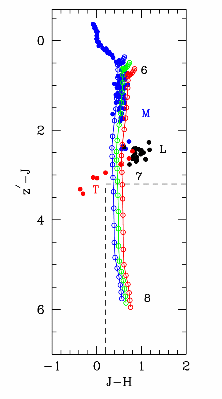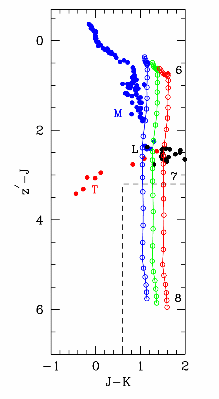Appendix A: Selection of very high-redshift quasars 5.8<z<8
We have made a detailed study of the opportunities for UKIDSS to
extend the explorable redshift range substantially beyond that
reachable by Sloan. Figure 2.3 (left) (section 2.7) shows how Fan et
al. (2000) found the highest-redshift quasar currently known,
z=5.8. At redshift z~6, in i'-z', quasars are redder than all stellar
objects except brown dwarfs, but bluer than brown dwarfs in
z'-J. Redshift z~6 quasars can be found by searching in the selection
box shown. In principal this method works up to about z=6.4, but
reaching beyond z=6 may be difficult for Sloan because of the limited
depth of the near-infrared data provided by 2MASS, and because the
quasars rapidly dim in z' beyond z=6 due to absorption in the Ly-alpha
forest. More z=6 quasars will be found by employing the deeper J data
from UKIDSS, but the redshift limit can only be extended substantially
by searching at longer wavelengths.
Using z' rather than i' as the dropout filter is an order of magnitude
more difficult. This is because in the red colour, which would now be
either J-H or J-K (or indeed H-K), the quasars are no longer bluer
than the brown dwarfs. This is illustrated in two plots in Figure
2.4. Using combinations of the z'JHK filters, quasars in the redshift
range 6<z<7.2 have very similar colours to cool M stars, and L
dwarfs. Either of the two-colour diagrams shown in Figure 2.4 become
effective at higher redshift still, beyond z=7.2, but three things act
against such a search: (1) the colour limit z'-J>3.2 is very red,
requiring very deep z' data, (2) the quasars are fainter, as further
away, and (3) the quasars are rarer, because of the decline in space
density. Clearly a z'JH survey is too ambitious as the first step
beyond Sloan - there may not be any z>7 quasars.


Figure 2.4. Two-colour diagrams showing how the z'
filter would be used as the dropout band. LHS is the
z'JH diagram, and RHS is the z'JK diagram. The
symbols and colour coding are as in the main text. Using either J-H
or J-K as the red colour, quasars do not stand out clearly from the
cool M stars and L dwarfs. Quasars at redshift z>7.2 could be selected
by identifying objects lying in the box shown. Note that in J-H and
J-K, brown dwarfs become bluer as they cool along the sequence L to
T.
The discussion above explains the motivation for introducing the new Y
filter, and surveying the redshift range 5.8<z<7.2, as laid out
in the main text.¹ In fact it is difficult to see how this
redshift range can be explored in any other way. This approach has the
advantage that the optical data already exist, and that the depth is
relatively easily achievable, because the filter is sampling the
quasar continuum.
WFCAM in any case is not really competitive for surveys in the z'
band, because optical cameras with much wider fields of view are being
planned. On a similar timescale to the UKIDSS surveys one can envisage
deeper i' and z' data becoming available. The J and H data of the
UKIDSS LAS will reach deep enough to make a survey for quasars in the
redshift interval 7.2<z<8 feasible. If UKIDSS finds quasars at
redshifts as high as z=7, this will provide the argument for a
wide-field very deep survey in z', using VISTA for example. As noted
in the main report, a survey covering 4000 sq. degs to z'=22.7 would
be required.
¹ We also considered a narrow filter Yn at
1.05-1.07micron, where the sky is darker. This filter is faster, but
because of the longer wavelength does not provide discrimination
between T dwarfs and quasars.

